Synthesis and Characterization of Carbon Fiber Based Porous CNTs-RGO/BDD for Application as Microelectrodes
- PDF / 726,478 Bytes
- 6 Pages / 612 x 792 pts (letter) Page_size
- 20 Downloads / 361 Views
Synthesis and Characterization of Carbon Fiber Based Porous CNTs-RGO/BDD for Application as Microelectrodes Amanda Araújo Silva1, Romário Araújo Pinheiro1, Cláudia do Amaral Razzino2, André Contin1 Vladimir Jesus Trava-Airoldi1, Evaldo José Corat1. 1
National Institute for Space Research, 1758, Astronautas Avenue, CEP: 12227-010 São José dos Campos, Brazil 2
University of the Valley of Paraíba, 2911, Shishima Hifumi Avenue, CEP: 12244-000 São José dos Campos, Brazil ABSTRACT Microelectrodes have attracted great interest for electroanalysis because of their unique properties, such as nonlinear diffusion, increased rate of mass transport and reduced capacitance, which allows a fast response. In this work, we created a porous nanocomposite of boron doped diamond (BDD) deposited on carbon nanotubes – reduced graphene oxide (CNTs – RGO) by Hot Filament Chemical Vapor Deposition (HFCVD) technique. The resulting material yielded porous BDD microelectrodes. On the first step, we have grown the CNTs on carbon fiber (CF) surface by Thermal CVD in a tubular reactor. Camphor solution and Fe-Co were carbon and catalyst source, respectively. For exfoliation, CNTs were treated by hydrogen plasma and oxygen plasma. We applied a seeding solution containing nanodiamond dispersed in KCl aqueous solution. Diamond nanoparticles interact with oxygen-containing groups on CNTs, promoting an efficient seeding. We deposited BDD films in an HFCVD reactor using methane/hydrogen gas mixtures. For doping, a partial hydrogen flow bubbled in a closed vessel containing a solution of boron oxide dissolved in methanol. The microelectrodes were characterized by Raman Scattering Spectroscopy, Scanning Electron Microscopy with Field Emission Gun and Cyclic Voltammetry. The crystalline quality of CNTs and BDD doping level were studied by Raman analysis. SEM micrographs showed that nanocomposite presented high porosity. Electrochemical analysis showed that the deposition of BDD on CNTs-RGO increased the electrochemical response of the microelectrode. Besides, this electrode presented a low capacitive current in comparison with BDD grown on flat substrates. Further, the porous BDD nanocomposite showed itself to be promising in electroanalysis. INTRODUCTION Microelectrodes have been widely used because of its characteristics, such as small currents, short experimental time scales, steady-state responses and extended range of sample media [1]. The most applied materials for microelectrodes fabrication are noble metals, that presents fast electron-transfer and high sensitivity. However, these materials versatility is limited by increasing background noise and reactivity between surface material and electrolyte, resulting in signal loss [2]. Carbon materials presented themselves to be a good alternative in microelectrode technology. Carbon nanotubes [3], carbon fibers [4], carbon nanofibers [5], boron-doped diamond (BDD) [6] and reduced graphene oxide [7] have already been applied in this field. BDD films are especially interesting for electrochemical purpos
Data Loading...










